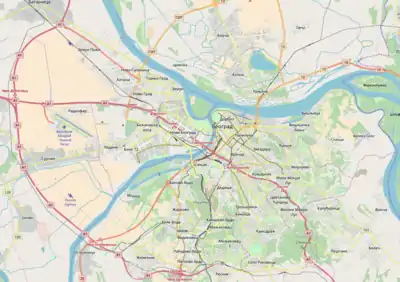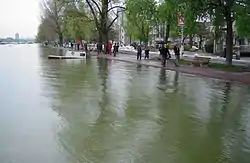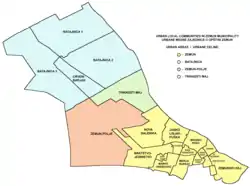Zemunski Kej
Zemunski Kej (Serbian Cyrillic: Земунски Кеј) is an urban neighborhood of Belgrade, the capital of Serbia. It is located in Belgrade's municipality of Zemun.
Zemunski Kej
Земунски Кеј | |
|---|---|
.JPG.webp) Zemunski Kej | |
| Etymology: Zemun Quay | |
 Zemunski Kej Location within Belgrade | |
| Coordinates: 44°50′36″N 20°25′02″E | |
| Country | |
| Region | Belgrade |
| Municipality | Zemun |
| Local community | Zemunski Kej |
| Population (2002) | |
| • Total | 12,112 |
| Time zone | UTC+1 (CET) |
| • Summer (DST) | UTC+2 (CEST) |
| Area code | +381(0)11 |
| Car plates | BG |
Location
Zemunski Kej, as its name suggests (Zemun's quay), is located alongside the right bank of the Danube. The promenade itself (officially named Kej Oslobođenja, Quay of Liberation) begins below the Gardoš hill, at the square of Veliki Trg and after 2.5 km (1.6 mi) continues into the municipality of New Belgrade. On the west it borders the neighborhoods of Donji Grad and Retenzija and on the south the neighborhood of Ušće in New Belgrade. To the east, in the Danube, is the Great War Island and its beach Lido.[1][2]
Quay
Promenade
Modern area of Zemun's Donji Grad was regularly flooded by the Danube. After massive 1876 floods, local authorities began the construction of the stony levee along the Danube's bank. Levee, a kilometer long, was finished in 1889.[3] When hydroelectrical plant Đerdap I began to fill its reservoir in the late 1960s, due to the backwater of the Danube, underground waters in Zemun and New Belegrade got elevated and the cellars of the buildings got flooded. To prevent this, the high embankment with the promenade was built in 1967 so the Danube rarely flooded the quay (most notably in 1981).[4]
In September 2007 reconstruction of the quay's 350 m (1,150 ft) long section began including further elevation of the embankment, widening of the pedestrian path and construction another one on separate level, completion of the cycling path, etc. Works, which were the first works on any embankments in Belgrade since 1990, were finished in 2008.[5][6] Works continued in 2010–2011. After being elevated by one meter in 1967 to the point 70.5 m (231 ft), embankment was further raised to 73.5 m (241 ft) in 2010 and 77 m (253 ft) in 2011, thus preventing any further floodings as the recorded water level was never higher than that. Over 450 m (1,480 ft) of the embankment was first solidified with 17,000 m3 of different materials, then consolidated with beams and further elevated with 20,000 m3 of sand, gravel and stone.[7]
Barges
In the early 1970s, architect Branislav Jovin designed the plateau and the quay in front of the Hotel Jugoslavija. Generally considered beautiful and elegant, the project allows the cascade descent from the hotel to the Danube's bank. Early 1990s saw the expansion of the splavovi (singular, splav), barge-clubs on the rivers. They originated along the banks of the Sava and expanded in the nearby Ušće neighborhood. After 1996, they spread along the quay in front of the hotel.[8][9]
The location was favorable as it was one of the rare point at the time, where there was enough parking space and the quay was arranged and concreted, while many other parts of the banks were the barges were located were still muddy and inaccessible. In the 1996–2000 period, the splavovi were swiftly anchored in front of the hotel and in such numbers, that they became so close to each other that guests from one splav were able to talk to the guests from another one. In this period, barges at Hotel Jugoslavija became one of the most popular hangouts, as the barges became one of the focal points of the vibrant Belgrade's nightlife, but were also connected with criminals and numerous incidents.[9] The entire section of the bank in front of the hotel has since then been colloquially known as "Chez Juga" (Kod Juge), after the shortened name of the hotel.
Majority of the barges placed in the last part of the 1990s are still operational, even under the same names, but are being replaced with much larger and modernized versions, unlike the other locations where splavovi appeared and disappeared, or changed names.[9]
Pier
Zemunski Kej is the main Zemun's landing area for numerous boats. In 2014 the government set the area of the former port as the future revitalized port area.[10] In April 2018 it was announced that the pier for the touristic ships and cruisers will be built on the quay. It was to be constructed near the Old Port Authorty (Stara Kapetanija) where the old Zemun port was located. Designed to accept ships up to 120 m (390 ft) long and 15 m (49 ft) wide, the project was to be finished by the 2019 nautical season.[11] It will be the second international touristic pier in Belgrade, after the one in Savamala neighborhood, on the Sava river. The central steel pontoon, 50 m (160 ft) long and 4 m (13 ft) wide, will serve for the boarding and disembarkation of the visitors.[12]
Construction ultimately began in June 2019 and was to last for 120 days, or to December 2019. However, since the works didn't go as planned, in November 2019 the deadline was moved to March 2020 and the next nautical season. When construction of the supporting piles began, the slabs from the previous embankment were discovered so as several submerged vessels. The pier's bridge will be also 50 m (160 ft) long, with 20 piles, while the pontoon will rest on two dolphins. The piles are being founded to the depth of 10 m (33 ft) in order to endure the pressure of river ice, while some pontoons will be attached to the piles so that it may rise and fall, following the change of the Danube's water level. There was some initial resistance to the project among the local population,[13] especially regarding the ecological aspect and influence on the nearby protected area of the Great War Island.[10] The pier was finished on 6 June 2020.[14]
Future
During the summer of 2020, a group of Zemun's citizens organized petition for the construction of permanent bridge to the Great War Island. In September 2020, the municipal administration of Zemun forwarded the preliminary design of the possible bridge to the city administration.[15] In October 2020, plans for massive reconstruction and extension of the quay were announced for 2021. The plans include extension to the north, upstream the Danube, to the Pupin Bridge. Deadline is set to 2022. Also, for 2022 city announced construction of the bridge from the quay to the Great War Island.[16] The ideas and announcement regarding the bridge already appeared from time to time, but the environmentalists and urbanists are continuously against the permanent bridge to the island.[17][18]
Characteristics

The residential areas include blocks 9-a and 11-c, while the mainly non-residential section includes blocks 9 and 11.[2] In the neighborhood there are pedestrian paths or green areas used for recreation (including a large, formerly seasonal amusement park) and commercial facilities. The area used to host seasonal travelling circuses. In time, it became vast, mostly children oriented playground and fair-like attraction, including carousel, children castles, popcorn, cotton candy, street artists, souvenir shops, etc.[19]
One of the largest hotels in Belgrade, "Hotel Jugoslavija" is located in the neighborhood, but it has been closed since the NATO bombing of Serbia in 1999 when it was badly damaged. It was partially reopened in 2007 as the largest casino in Belgrade. The key is also location of several old and famous kafanas in Zemun, like Venecija, Stara Kapetanija, Šaran, etc.
For the most part, the promenade is parallel to the street opened for traffic. Near the beginning of the promenade is one of major roundabouts in Zemun, with terminal bus stops for many public transportation bus lines (82, 85, 610, 611, 705). The promenade continues around Ušće and makes one continuous pedestrian path next to the neighborhoods of Staro Sajmište and Savski Nasip, alongside the left bank of the Sava.[1][2]
As the bank (and thus the quay, too) follows the line of the nearby Great War Island, it is the beginning point of the pontoon bridge which seasonally connects the Lido beach on the island with the mainland.[20][21]
The main access street to the southern, Hotel Jugoslavija section, is Bulevar Maršala Tolbuhina, previously called Goce Delčeva Street. In the 21st century, a numerous food venues were opened. They were mostly fast food and take-out restaurants and grills, and their number continuously grew ("more fast-food venues than elements in Mendeleev's periodic table"). In many cases they are opened 24/7, and in time the social phenomenon developed - constant queues of people which spread along the street waiting for food day and night. For this, the street became known as the "Street of the Hungry", "Valley of the Hungry" or "Has Vegas" (has is Belgrade slang for eating).[22][23]
Memorials
Airmen monument
A monument dedicated to 11 pilots of the Royal Yugoslav Army Air Force, killed in action during the Axis attack on Yugoslavia in 1941, was built in 1994. It was sculptured by Miodrag Živković.[24]
Zemun Railway Station memorial
There is a memorial commemorating the original Zemun railway station. The station was located close to the modern Hotel Jugoslavija. It was built in 1883, during the rule of Austria-Hungary, when the railway, which connected Zemun to Novi Sad, was finished. In 1884 the railway was extended across the Sava into the Kingdom of Serbia as the first railway in the country. The station was operational until 1970. Architect Milun Stambolić designed a memorial complex which consists of five pillars, which used to hold the station's overhang, and several meters of railroad tracks. The complex is placed on the plateau next to the hotel, on the small elevation above the promenade along the Danube.[25] The memorial complex was set in the 1980s.[26]
John Hunyadi monument
On 22 July 2019, a monument to the medieval Hungarian knight John Hunyadi (Serbian Cyrillic: Сибињанин Јанко, Sibinjanin Janko), was dedicated on the promenade. Hunyadi defended Belgrade against the Ottoman Turks during the 1456 Siege of Belgrade. Presidents of both Serbia and Hungary, Aleksandar Vučić and János Áder, attended the dedication.[27]

Immediately, the monument became the subject of ridicule. Hunyadi was described as being placed in the shower stall. The statue holding a sword, work of Hungarian sculptor István Madarasi, was unfavorably compared to the existing monuments to Hunyadi in Budapest and Romania. Described as looking like a cartoon or a comic book character, it became a hit on social media, where people "guessed" who is actually represented by the statue: actors Zoran Radmilović (in his iconic Ubu Roi role) and Ljuba Moljac, theatrical director Ljubiša Ristić, DJ and radio host Marko Janković (radio host), cartoon, animated or literature characters Asterix, Sir Giles, Don Quixote and Tin Woodman, Joan of Arc with mustache, Kinder Surprise toy, etc.[28][29][30][31][32]
A week after the unveiling, on the night of 30 to 31 July, the statue's sword, which was loosely attached to the statue, was stolen but police apprehended the culprits on the same day.[33][34] They were three art students, claiming they removed the sword in protest.[35][36] In September 2019 someone placed a wooden sword, decorated with flowers, in the statue's empty hand.[37] Madarasi reattached the original sword on 2 October 2019. By January 2020 the effects of the elements on the copper statue were quite visible.[38]
Branko Najhold memorial bench
On 18 June 2020, a memorial to Branko Najhold (1947-2016) was dedicated on the promenade. Najhold was an author, founder of the International Zemun's Caricature Salon and an avid chronicler of Zemun. The memorial, representing a figure of Najhold sitting on a bench, was sculptured by Stevan Filipović.[39]
Administration
Zemunski Kej made a local community (mesna zajednica, municipal sub-administrative division) within the municipality of Zemun. It split from the local community of Donji Grad before the 1991 census, when it had a population of 3,927.[40] In the next census, in 2002, it had 3,649 inhabitants.[41] Local communities in the urban core of Zemun were later abolished.
Including local communities which are adjacent to the entire promenade (Dunav and Jugoslavija), the entire neighborhood had a total population of 13,385 in 1991 and 12,112 in 2002.[40][41]
References
- Tamara Marinković-Radošević (2007). Beograd - plan i vodič. Belgrade: Geokarta. ISBN 978-86-459-0006-0.
- Beograd - plan grada. Smedrevska Palanka: M@gic M@p. 2006. ISBN 86-83501-53-1.
- Miloje Jovanović Miki (2 December 2010). "Brdo Gardoš nije brdo" (in Serbian). Politika. Archived from the original on 31 May 2016.
- I.Ješić (8 April 2009). "Podzemne vode više ne prete Paviljonima" (in Serbian). Politika.
- Politika, 27 September 27, 2007, p.26
- "Sanacija obaloutvrda sa pristanom na delu Zemunskog keja" (in Serbian). Građevinarstvo.rs. 30 July 2010.
- V.V., "Zemun se štiti od stogodišnjih voda", Politika (in Serbian)
- Katarina Đorđević (5 November 2017), "Pola veka beogradskih diskoteka" [Half a century of Belgrade disco clubs], Politika (in Serbian), p. 9
- Bane Gajić (21 December 2018). "Kako su splavovi postali važan deo Beograda" [How splavovi became important part of Belgrade]. Vice (in Serbian).
- Branka Vasiljević (28 December 2019). Утицај пристаништа на животну средину [Effect of the port on the environment]. Politika (in Serbian). p. 15.
- Beta agency (24 April 2018). "Turistički kruzeri od sledeće sezone pristaju u Zemun" [Touristic cruisers will stop at Zemun from the next season]. Večernje Novosti (in Serbian).
- Ana Vuković (26 April 2018). "Крузери ће пристајати у Земуну" [Cruisers will stop in Zemun]. Politika (in Serbian). p. 15.
- Branka Vasiljević (18 November 2019). "Niče pristan u Zemunu" [Pier in Zemun rising]. Politika (in Serbian).
- Julijana Simić Tenšić (7 June 2020). Земун добио међународни пристан [Zemun got international pier]. Politika (in Serbian).
- Milan Janković (2 September 2020). "Odlazi pontonska ćuprija" [Pontoon bridge going away]. Politika (in Serbian). p. 15.
- Dejan Aleksić (24 October 2020). Од следеће године преуређује се и Кеј ослобођења [Kej Oslobođenja is also being reconstructed from the next year]. Politika (in Serbian). p. 13.
- Branka Vasiljević (3 July 2019). Припреме за летњу сезону на земунском Лиду [Preparation for the summer season at Zemun's Lido]. Politika (in Serbian). p. 15.
- Aleksandar Milenković (26 July 2017), "Oblak nad Velikim ratnim ostrvom" [Cloud over Great War Island], Politika (in Serbian)
- Milan Janković (16 August 2020). Царство на Земунском кеју [Zemunski Kej Empire]. Politika (in Serbian).
- D.Mojić (3 July 2008), "Počelo leto na Lidu" [Summer at Lido began], Glas javnosti (in Serbian)
- N.M. (1 July 2008), "Sezona na Lidu od sutra" [Season on Lido starts tomorrow], Politika (in Serbian), p. 24
- Milan Janković (24 July 2020). У "улици гладних" скоро као некада [In the "Street of the Hungry" like in the old days]. Politika (in Serbian). p. 16.
- Filip Marković (23 March 2020). "Direktno sa beogradskog asfalta #3 – Ulica gladnih" [Directly from the Belgrade streets #3 - Street of the Hungry]. Student (in Serbian).
- Branka Vasiljević (15 March 2019). "Spomenik pilotima obnoviće opština Zemun" [Monument to pilots will be restored by the Zemun municipality]. Politika (in Serbian). p. 14.
- Zoran Nikolić (2 November 2017), "Beogradske priče: Čudne gradske "granične linije"" [Belgrade stories: Strange city "border lines"], Večernje Novosti (in Serbian)
- Branka Vasiljević (14 September 2019). Железничко благо Београда [Railway treasure of Belgrade]. Politika (in Serbian). p. 15.
- FoNet (22 July 2019). "Otkriven spomenik Sibinjaninu Janku, Vučić i Ader o vojskovođi i odnosima" [Monument to Sibinjanin Janko dedicated, Vučić and Áder discussed the military leader and [Serbian-Hungarian] relations] (in Serbian). N1.
- Milan Janković (29 July 2019). Од један до пет – Сибињанин Јанко [1 to 5 – Sibinjanin Janko]. Politika (in Serbian). p. 14.
- M.Beljan (23 July 2019). "Kako je zaista izgledao Sibinjanin Janko i da li je ovo Asteriks? Sukob oko novog spomenika" [How did Sibinjanin Janko really look like and is this Asterix? Confrontation regarding new monument]. Telegraf.rs (in Serbian).
- Ivan Živkov [@izivkov] (22 July 2019). "Hunjadi Janoš u Budimpešti i Sibinjanin Janko u Beogradu" [Hunyadi Janos in Budapest and Sibinjanin Janko in Belgrade] (Tweet) (in Serbian) – via Twitter.
- Veljko Pajović [@veljkoveseljko] (23 July 2019). "Sibinjanin Janko. Tanko, tanko…" (Tweet) (in Serbian) – via Twitter.
- Antonela Riha [@RihaAntonela] (22 July 2019). "Ovo vam je Sibinjanin Janko…" [This is Sibinjanin Janko for you…] (Tweet) (in Serbian) – via Twitter.
- Branka Vasiljević (1 August 2019). У Земуну украден мач Сибињанин Јанка [Sword of Sibinjanin Janko stolen in Zemun]. Politika (in Serbian). p. 1 & 14.
- Srna (31 July 2019). "Ukraden mač sa tek postavljenog spomenika Sibinjanin Janku u Zemunu" [Sword stolen from the recently placed monument to Sibinjanin Janko in Zemun] (in Serbian). N1.
- FoNet (1 August 2019). "Studenti Likovne akademije ukrali mač Sibinjanin Janka iz "stručnih razloga"" [Artistic Academy students stole the sword because of “expert reasons”]. N1 (in Serbian).
- Milan Janković (5 August 2019). Од један до пет – Јанков мач [1 to 5 – Janko’s sword]. Politika (in Serbian).
- Branka Vasiljević (10 September 2019). "Sibinjanin Janko dobio drveni mač" [Sibinjanin Janko gets wooden sword]. Politika (in Serbian). p. 14.
- Branka Vasiljević (20 January 2020). Сибињанин Јанко већ осећа ћуди времена [John Hunyadi already experience the weather's moodiness]. Politika (in Serbian). p. 14.
- Branka Vasiljević (18 June 2020). Спомен-клупа Бранку Најхолду на Земунском кеју [Branko Najhold's memorial bench in Zemunski Kej]. Politika (in Serbian). p. 17.
- Stanovništvo prema migracionim obeležjima – SFRJ, SR i SAP, opštine i mesne zajednice 31.03.1991, tabela 018. Savezni zavod za statistiku (txt file).
- Popis stanovništva po mesnim zajednicama, Saopštenje 40/2002, page 4. Zavod za informatiku i statistiku grada Beograda. 26 July 2002.